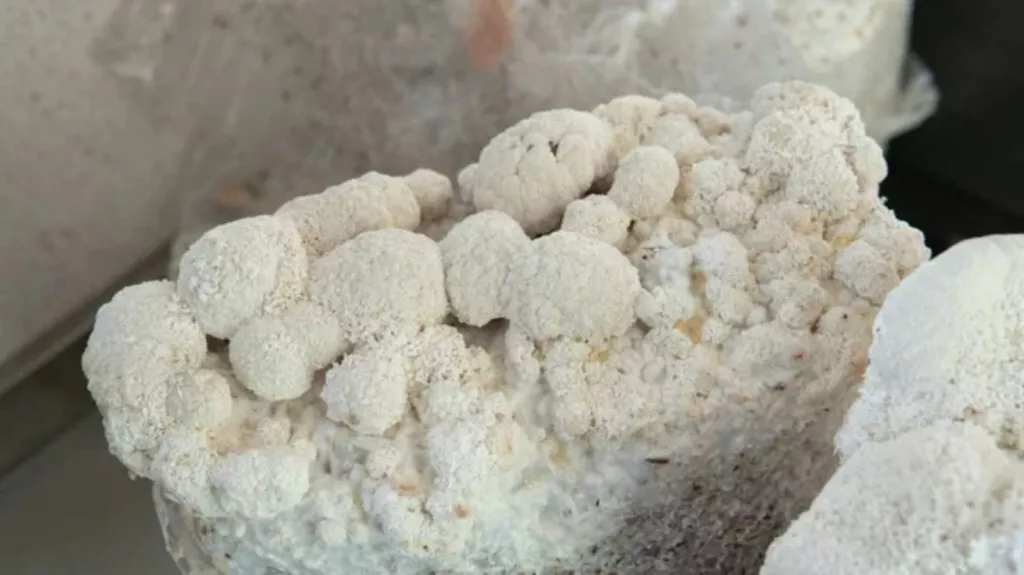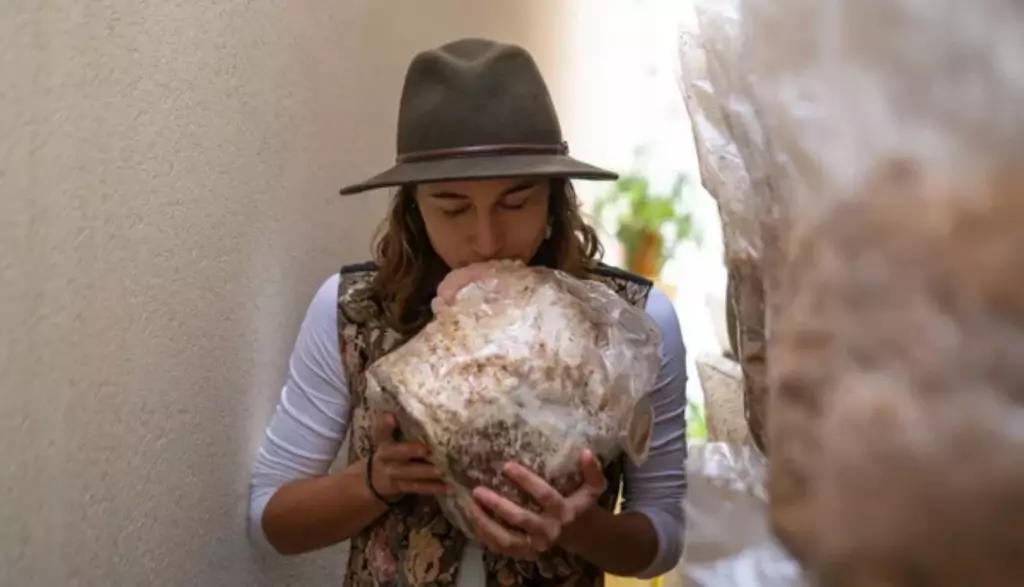Lions Mane Fruiting Conditions (Temperature & More)
The beauty of mushroom farming is that you can choose which mushroom varieties you want to grow. If you successfully grew oyster mushrooms, you could explore other unique mushroom types, such as lion’s mane. To help you, we’ve rounded up in this article the fruiting conditions needed when growing lion’s mane mushrooms.
The ideal fruiting temperature for lion’s mane mushrooms is between 65 and 75°F (18 and 24 °C). While a lion’s mane can grow even in cooler temperatures, anything warmer can slow down its growth. The ideal humidity to allow fruiting must be between 85 and 95% relative humidity with a CO2 level of about 500 to 1,000 ppm.
There is still so much to learn about lion’s mane mushrooms. The increasing interest in the health benefits they provide makes them an excellent choice to grow on your small mushroom farm. Learn more exciting facts about these mushrooms as you keep reading below.
Summary
- The temperature requirement to encourage lion's mane mushrooms to fruit is 65–75°F (18–24°C).
- When achieving fruiting conditions for lion's mane mushrooms, other factors to consider are humidity, fresh air exchange, and CO2 level, as well as the fruiting containers.
- Lion's mane mushrooms are valued not just for their taste but also because of their many health benefits.

On this page:
The Ideal Fruiting Conditions for Lion’s Mane Mushrooms
The ideal temperature range that encourages lion’s mane to fruit is within 65-75°F (18-24°C). The temperature must be kept within range to avoid stunted growth.
Like all mushroom types, lion’s mane mushrooms undergo through three main stages of development: colonization stage, pinning stage, and fruiting stage, before they can be harvested. But to produce good quality fruiting bodies, the best substrate must be chosen.
Lion’s mane mushrooms commonly prefer substrates that mimic natural trees such as sterilized hardwood sawdust. You can mix this with 10% wheat bran or use a 50:50 mix of sawdust and hydrated soy hulls to create what is known as Masters-Mix, which is proven to increase mushroom yield.
When all things are prepared, you can start growing your lion’s mane mushrooms. To achieve a soft, fluffy, and pom-pom-like appearance of the fruits, you must set the right fruiting conditions.
The following fruiting conditions must be adjusted accordingly:
- Adjust temperature to 65-75°F (18-24°C).
- Keep relative humidity level within 85-95%.
- Maintain CO2 level within 500-1,000 ppm.
- Ensure 5-8 fresh air exchange rates per hour to achieve the fluffy pom-pom appearance.

Lion’s mane mushroom (Hericium Erinaceus) is a large, white, pom-pom-like mushroom. It has gills that cascade downwards as it grows, giving it a shaggy look like a lion’s mane from which its name is derived.
These mushrooms look different from commonly known mushrooms because they have a soft, spongy texture, sometimes, even hollow. They have an internal structure with branches extending from a single base like a cauliflower.
Their sweet, mild flavor is comparable to crab or lobster meat, so they can be a good meat substitute. But aside from being edible mushrooms, lion’s mane is highly valued for its health benefits, especially with studies claiming that these mushrooms can improve cognitive abilities.
With a wide array of health benefits and potential medicinal uses to cure dementia, reduce anxiety and depression, and repair nerve damage, lion’s mane easily becomes one of the most profitable mushrooms to grow.
If you plan to grow lion’s mane, they are very easy to grow, but one must have experience already with easy-growing mushrooms such as oyster mushrooms. This is because the mycelium of lion’s mane mushrooms is very fine, which makes it hard to guess if they have fully colonized the block and are ready to fruit.
Lion’s mane mushrooms grown on logs do not grow fast and can take one to two years before the first flush harvest, but once it starts producing, you can have a continuous supply for up to 6 years. For lion’s mane grown in bags, they grow much quicker and can be harvested in a month after inoculation.
Let's Provide the Right Environment for Fruiting Lion’s Mane Mushrooms
One of the best ways to increase mushroom yield and harvest good quality mushrooms is by providing them with the right environment that allows them to flourish.
For starters, when fruiting lion’s mane mushrooms, choosing your fruiting containers is one important factor to consider. Lion’s mane grows best in a mushroom grow bag. The bag can also be used as a humidity tent for the substrate.
You can spray the bag once or twice a day while allowing the mushrooms to fruit out of any slits in the bag. Remember not to cut off the top of the bag because big holes will produce smaller fruits while smaller holes will ensure fewer but larger fruit.

Growing bags are not the only containers where a lion’s mane can grow. They can also grow in the following fruiting containers:
-
Buckets: Buckets are also conducive containers for growing Lion’s mane mushrooms. But to make it ideal, ensure that the top is covered, and holes are punched in the bucket to allow the growth of fruiting bodies.
-
Jars: Jars provide the perfect enclosed environment for the mushroom substrate. If you want to grow lion’s mane in a jar, fill the jar with substrate and punch holes in the lid to allow fruiting of the mushrooms.
Aside from selecting the best fruiting containers, part of setting the right environment is setting the ideal fruiting temperature.
As for humidity, keeping it constant at 85-95% ensures consistent, abundant yields of large and healthy lion’s mane mushrooms. To maintain such conditions, it’s best to invest in a humidifier to control the humidity level.
Although manual misting can be done, you must ensure not to spray directly onto the fruits because these mushrooms are sensitive to bruising. Bruising may cause a greenish discoloration.
One good indicator of lack of humidity is dry, cracked, leathery mushrooms with slight yellowish or brownish discoloration.
On top of humidity and temperature, another important factor to consider is the sufficiency of fresh air in the growing bags or containers. Fresh air exchange is the amount of fresh air moving around the grow kit. Mushrooms are like humans in a way that they breathe in oxygen and breathe out CO2.
Since mushrooms exhale carbon dioxide which can accumulate within the fruiting, the amount of CO2 that must be maintained during fruiting is 500-1,000 ppm only. If CO2 is too much, it may result in your mushrooms growing like the following:
- Mushrooms are not round in shape
- Mushroom has a lot of spiky arms
- Mushrooms will look long, stretched, and deformed
- Mushrooms look more like branchy coral than a fluffy pom pom
These scenarios can be prevented by increasing the amount of fresh air exchange in your fruiting bags. You can do this by putting more air holes in the humidity tent. At least 5-8 fresh air exchange rates per hour are recommended. The more the lion’s mane is growing, the more fresh air it will need.
Note, however, that increasing fresh air exchange can often directly reduce humidity, so better be on the watch.


